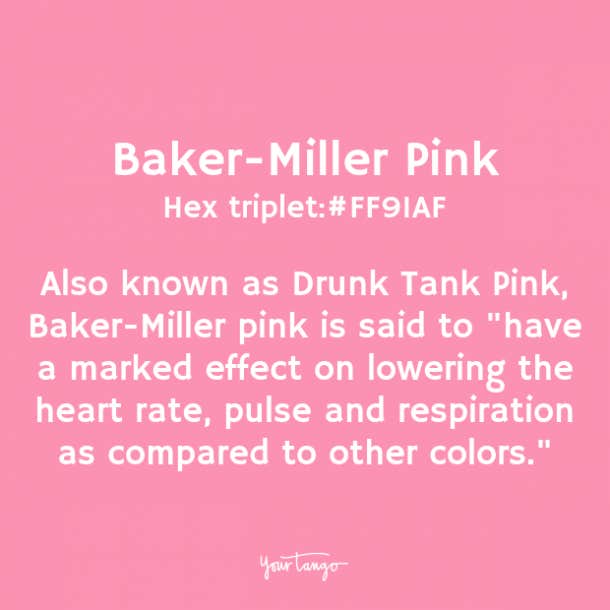For example, the color red has been proven to stimulate passion and anger and has been shown to elevate blood pressure and heart rate, while blue is thought to bring about feelings of calmness and serenity. And Baker-Miller pink, a sort of Pepto Bismol pink originally developed by mixing one gallon of pure white indoor latex paint with one pint of red trim semi-gloss outdoor paint, is apparently used for mind control. Photo: Rising Star / Shutterstock RELATED: The World’s Ugliest Color, According To Science
Why are prisons painted Baker-Miller Pink?
In the 1960s and 70s, researcher Alexander Schauss decided to study psychological and physiological responses to the color pink. By the late 1970s, he claimed to have found a shade of pink, which he called P-618, that had “a marked effect on lowering the heart rate, pulse and respiration as compared to other colors.” To test his theory, Schauss convinced the directors of the Naval Correctional Facility in Seattle, Baker and Miller (hence the name Baker-Miller pink), to paint the walls of the facility with this pink color. They then monitored the behavior of the inmates and found that “since the initiation of this procedure on 1 March 1979, there have been no incidents of erratic or hostile behavior during the initial phase of confinement," and that it took only 15 minutes of exposure to the color to subdue inmates. The results of this study led to an explosion in the use of Baker-Miller pink, which began being used in jail intake rooms (or “drunk tanks,” leading to the nickname Drunk Tank Pink), psychiatric hospitals, and even schools. A 1982 New York Times article described how a juvenile detention center in San Bernadino, California started putting aggressive detainees in a Baker-Miller pink room in which they would “relax, stop yelling and banging and often fall asleep within 10 minutes.” The effects of the color were considered so powerful it began to be weaponized by some sports teams. During the ‘80s, Colorado State’s football program painted the visiting team’s locker room in Baker-Miller Pink “in an attempt to relax the opposing team — a detrimental physiological state in a highly-charged physical sport. The impact was deemed to be so intrusive that the Western Athletic Conference governing body introduced a rule where both teams’ locker rooms had to be painted the same color.” And more recently, Kendall Jenner reportedly painted her living room Baker-Miller pink due to it’s reportedly “calming and appetite suppressing qualities.” RELATED: Only 1 In 4 People Can See All The Colors In This Image. Can You?
Does Baker-Miller Pink actually work?
Yes… but then also no. In 1988, researchers James E. Gilliam, Ph.D. and David Unruh, Ph.D. tested Shauss’ theory of the effects of Baker-Miller pink on blood pressure, pulse rate, grip strength, and performance and found the results weren’t exactly convincing. They warned that people “exercise caution” when implementing the use of the color. Schauss himself suggested that the effects of Baker-Miller pink may have more to do with the novelty of seeing the color as opposed to the color itself. And a 2018 study theorized that the perceived femininity of the color pink in the “exclusively masculine environment” of prison was emasculating and therefore caused the men to behave less aggressively. RELATED: The Psychology Of What Your Favorite Color Says About You Micki Spollen is an editor, writer, and traveler. Follow her on Instagram and keep up with her travels on her website.
